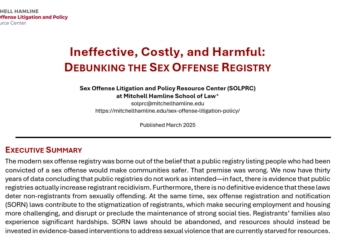NARSOL: Halloween 50 years ago and now
By Sandy . . . Looking at some of the headers of the articles sent in today’s alerts, I cannot help but shake my head in wonder.
“Communities explore other Halloween plans after sex offender law abolished,” announces a Missouri news outlet. This is in regard to the Missouri Supreme Court’s recent ruling that requiring those on the state sex offender registry to post “No candy here” signs at their homes is unconstitutional.
Even if the signage requirement were not only one part of a comprehensive set of restrictions, would this require that Halloween plans be changed?
Another media outlet says, “California’s tiered sex offender registry law allowed two convicted sex offenders to remain off list.” This is a reference to changes in the registry law in California that allows registrants to be removed after a certain length of time. This is part of a legal process, and a process followed in many states, not, as the article implies, some “loophole” that is used to skirt the law.
In spite of the online outlet Patch abandoning its “red dot” Halloween safety maps in virtually every state and location, a few Illinois editors are running them, “warning” parents where registrants in their communities live. NARSOL has done battle with Patch for years and are pleased that so few editors remain who are willing to defy all empirical evidence by printing this information.
Changing Halloween plans, dismay over legal registry procedures, and trick-or-treat “safety” maps—why would these have me shaking my head in wonder? Perhaps because I am old enough to remember the time when the registry and all it has spawned did not exist.
What was life like then? Were children molested while they were trick-or-treating? Did community members feel panic over who might live down the street? Were sexual crime and reoffenses rampant? Were children grabbed daily—or weekly—or monthly–out of school playgrounds and parks?
No.
Empirical evidence shows the rate of reoffense by those convicted of sexual offenses has remained steady over many years, both before the registry existed and since. As shown in an AI overview, “According to research, there is little evidence to suggest that sexual crime recidivism was significantly worse before the existence of sex offender registries, with most studies indicating that sex offenders generally have a low recidivism rate regardless of the registry system; in fact, some studies even suggest that public registration could potentially increase recidivism rates by making it harder for offenders to reintegrate into society and find employment, potentially leading to further criminal behavior.”
And as far as Halloween, this has been said many times, and it remains true: research reveals no instance of a child being abducted or molested by a person on the registry while trick-or-treating. As far as can be determined, the only time this has happened was pre-registry, in 1973—51 years ago—in Wisconsin. The victim was a little girl named Lisa French, and the perpetrator was someone who, even if there had been registries, would not have been registered.
This is a good place to remember that virtually all sexual crime against children is committed by those who are not already registered. What does this mean for Halloween?
Quoting myself from the Lisa French piece:
According to research, approximately 96% [of the perpetrators of sexual crime] have no previous history of this type of crime and therefore are on no registries. They aren’t locked up or confined to their homes with all lights off on Halloween. They aren’t checked on by law enforcement to assure that they are keeping themselves away from all child-related activities. They don’t show up as red dots on a map warning parents away from those addresses.
They are in your homes, at your parties, in your neighborhoods. They answer the doors and hand out candy to your children. They are where they have always been. And all of the Halloween restrictions on all of the people on sexual offense registries across America mean absolutely nothing.
Originally posted from NARSOL: https://www.narsol.org/2024/10/halloween-50-years-ago-and-now/

Written by Sandy Rozek





